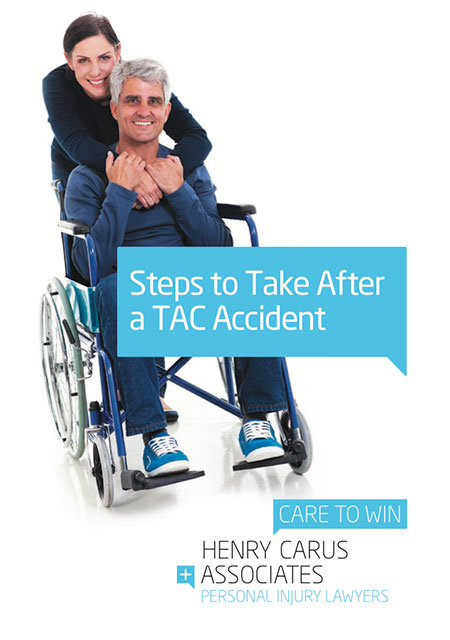
Determining fault for a car accident can be challenging. It is easy to feel overwhelmed, making it difficult to spot important details and gather the necessary evidence.
The question of who is at fault may not affect your entitlements with the TAC. Nonetheless, it is crucial to identify who or what may have caused the accident and understand what such a determination means for your TAC claim.
Henry Carus + Associates have unparalleled experience determining fault for car accidents and representing clients in TAC and common law matters throughout Victoria. Call 03 9001 1318 today for a FREE, no-obligation consultation.
How Is Fault Determined in a Car Accident?
Prompt investigation is necessary to collect evidence and examine factors at the scene that may have contributed to the crash. Common issues that lead to car accidents in Melbourne and other areas of Victoria include:
- Excess speed
- Failure to give way
- Disobeying traffic signs and signals
- Mobile phone usage and other distractions
- Inadequate lookout when cornering, changing lanes, or merging
- Following too closely
- Drink driving
Eyewitness testimony, photographs showing the position of the vehicles, and other evidence can be used to determine who is at fault for the car accident. If possible, make note of important details such as the speed limit on the stretch of road you were driving, lighting and weather conditions, etc. These can be used to support your claim against a negligent driver.
Any road accident that results in injury must be reported to the police straight away. When the police assess fault for an accident, their concern is identifying potential violations and offences—not your right to compensation.
You should consult a TAC accident lawyer as soon as possible if you were struck by a driver who was engaging in unsafe behaviour. A qualified lawyer can aid you in determining fault for the car accident—by reviewing the police report and gathering additional evidence—as well as identify your legal options.
What If the Accident Was Partly My Fault?
It is not uncommon for fault to be shared in the event of a car accident. While you should never admit fault if the circumstances are unclear, it is important to know that a finding of partial responsibility does not bar you from pursuing compensation.
The State of Victoria uses a contributory negligence standard in personal injury matters. If it is determined that you are partly at fault for the car accident that led to your injuries, the following standard applies:
‘…the damages recoverable in respect of the wrong must be reduced to such extent as the court thinks just and equitable having regard to the claimant’s share in the responsibility for the damage.’
– Wrongs Act 1958 S. 26(1)(a)
For example, say you are travelling straight through an intersection when a driver turns in front of your car. The other driver is found to be mostly responsible for the accident, but it is determined that you were speeding just prior to the collision.
Ultimately, it is found that the other driver was 90% responsible for the accident while you are assigned 10% of the fault. If the matter went to court, any damages you are awarded would be reduced by 10% (i.e., you would still be entitled to 90% of the compensation you are due).
When Do Questions of Fault Apply?
The Transport Accident Commission (TAC) is responsible for managing claims and compensating individuals who are injured in motor vehicle accidents in Victoria. Most TAC benefits are provided on a no-fault basis, including:
- Medical expenses and supports
- Income support
- Return to work support
- Permanent impairment benefit
- Support for family members (if applicable)
You do not need to prove that any person or organisation was at fault for the accident to claim these benefits. However, determining fault for a car accident will be necessary if you are entitled to pursue common law damages.
What Is Common Law Compensation?
Common law damages are an additional form of compensation awarded to people facing substantial impacts as a result of their road accident injuries. As such, only those who suffer a serious injury may be eligible for common law damages.
If you (a) have a ‘serious injury’ and (b) someone else was at fault for the accident, you likely have a claim for common law compensation. Damages you may be entitled to in a common law claim include:
- Loss of past earnings
- Loss of future earnings/loss of earnings capacity
- Pain and suffering
- Loss of amenities of life
- Loss of enjoyment of life
Although the other driver (and/or any additional parties) may be at fault for the car accident, common law compensation is paid by the TAC. Unfortunately, this puts the TAC’s interests in direct conflict with yours. This can lead to unfair allegations of fault on your part and other tactics designed to reduce or even deny the compensation you are due.
Need Help Determining Fault for a Car Accident?
The aftermath of a car accident is a confusing and stressful time. It may be difficult to know who or what caused the accident, let alone what steps you need to take to protect your legal rights and claim any entitlements.
Henry Carus + Associates can handle the complexities of determining fault for a car accident, lodging all applicable claims with the TAC, and seeking maximum compensation on your behalf. You Deserve More, and our lawyers will pursue all benefits and additional compensation—including common law damages.
Our firm has offices in Melbourne and many additional locations throughout Victoria. If you were injured in a car accident that was not your fault, contact Henry Carus + Associates today for your FREE, no-obligation consultation.
 Call Us Today
Call Us Today



